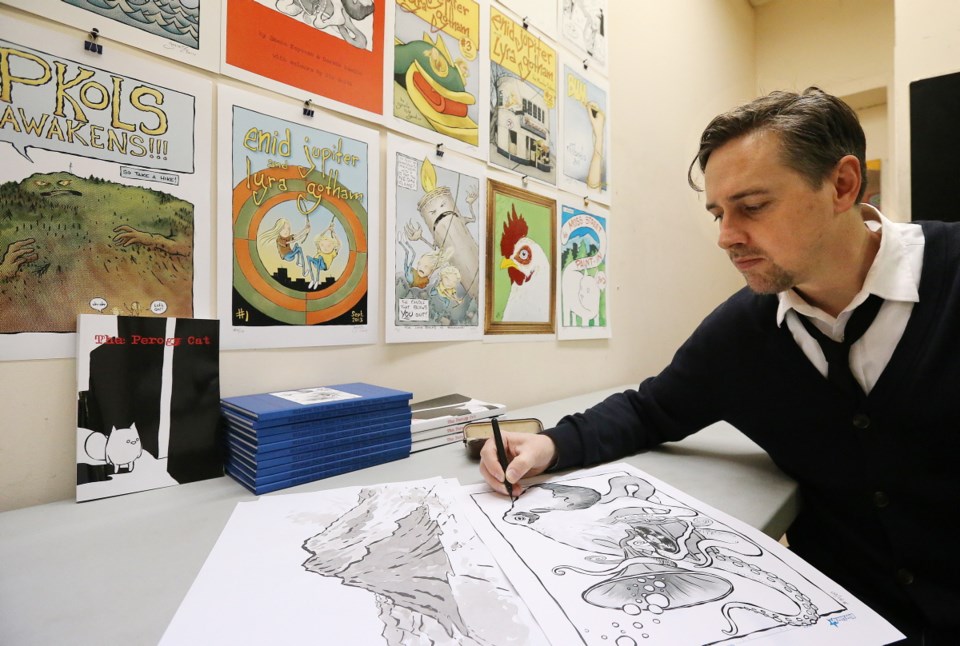Gareth Gaudin sees two kinds of comic-book lovers: One looks for magic in the words and pictures, while the other won’t remove the plastic wrap.
Gaudin, owner of Legends Comics and Books on Johnson Street, likes to think of himself as firmly in the first category. A first issue of Superman can be worth millions, but that’s not why he reads, sells and draws comics. It’s the stories and the pictures that are important to him.
“I have a Spiderman No. 1 [worth up to $60,000 to collectors] and I folded it in half and put it in my pocket just to prove the enjoyment is way more important than the idea that it’s some sort of savings bond,” said Gaudin, 41, a lifelong Victoria resident.
“If two comics come into my store, one in mint condition and the other beat up and some kid has drawn on it, I’m always drawn to the used one. I respect that.”
Gaudin will lead a workshop for all ages on Sunday at the Royal B.C. Museum, where he has been artist in residence for about two years.
In a secret room in the museum’s “Old Town” exhibit, he will explore the comic-book world of super-heroes and even help participants devise their own comics.
He also begins a sold-out workshop at Legends on Thursday for kids ages seven to 12 on the basics of comic-book creation, teaching things like how to draw comics and how to tell the stories with separate panels.
But he doesn’t want his students to focus on drawing only the anatomically correct, bulging muscles of a super-hero. Even stick figures have been used as great comic-book characters.
“I’ll be looking for that default style, the one kids use when they think no one is paying attention, to tell them: ‘That can be your style,’” said Gaudin.
“If you can acknowledge that you are the only person in the world with that style, then it can be your voice. You might even write the great Canadian novel in pictures.”
Gaudin has been reading, drawing and writing comic books since he was a child. He recalls one pivotal moment when his mum took him to the newsstand in the old Turner Building at Richmond Street and Foul Bay Road, where he purchased a Godzilla comic.
He said he always loved monsters and dinosaurs as a kid. But monster shows came on TV only once a week. So it was a revelation to learn these creatures could be at hand, whenever he wanted a fix, in the pages of a comic book.
“I loved the idea that I was in control,” he said. “If I wanted to see monsters fighting each other, then I just opened my comic book.”
As a kid, he even taught himself to read from comic books. There were moments, however, when pronunciation got the better of him.
“The Hulk would always say ‘puny humans,’ but to me it was always ‘punny human,’” said Gaudin. “ ‘Punny human!’ I remember yelling at my dad.”
While he never stopped loving comic books, he also remembers a time, especially in the 1980s, when comic books became something shameful. They were the sort of thing you didn’t dare read on a bus for fear of getting beat up.
Gaudin took a visual-arts degree at the University of Victoria, where he created the cartoon Pyrogy Cat to impress and attract a young woman, Bronwyn, now his wife.
He has even helped create a comic starring his two daughters as characters. To say comics are important to him would be a super-sized understatement.
“I have accumulated the most amazing life for myself,” said Gaudin. “I get to get up every morning to sell comics, read comics and draw comics.
“I met my wife with a comic. I have two daughters who are in comics. You could say my whole life is in comics.”
Gaudin has also seem the evolution of comic books, which have been regarded as everything from harmless fun to propaganda, subversive, collectors’ items and even literature.
For example, Maus by Art Spiegelman, depicting the Second World War Holocaust in cartoon form with mice for Jews and cartoon cats for Nazis, won the Pulitzer Prize in 1991.
According to Gaudin, biographies and autobiographies now make up a huge portion of the market. A Canadian graphic novel depicting the life of Louis Riel sold millions. Essex County by Jeff Lemire, the story of a Canadian farm town, made it into CBC’s Canada Reads recommendations.
Gaudin said superheroes now make up less than 20 per cent of the comic-book market. Characters like Spiderman and Superman are only kept alive by corporations to promote interest in the movies.
Likewise, women have gone from a minority readership to the point where Gaudin estimates they make up about 70 per cent of the customers at Legends.
So when he talks to people about comic books, he wants them to know they are stepping into a whole new dimension of expression. He even prefers to spell them “comix,” short for a co-mixture of words and art.
“That’s always what we are looking for — that perfect mingling of two forms, literary and artistic,” said Gaudin. “A kind of magic comes out of this.”
For more information about Gaudin and Legends, go to legendscomics.ca.
For details of the upcoming museum event, check out royalbcmuseum.bc.ca and go to Comics Workshop.



